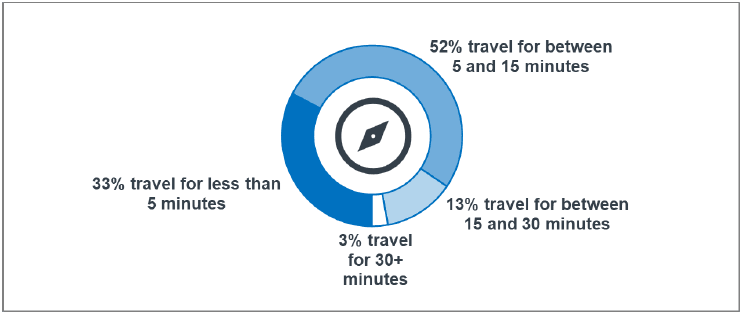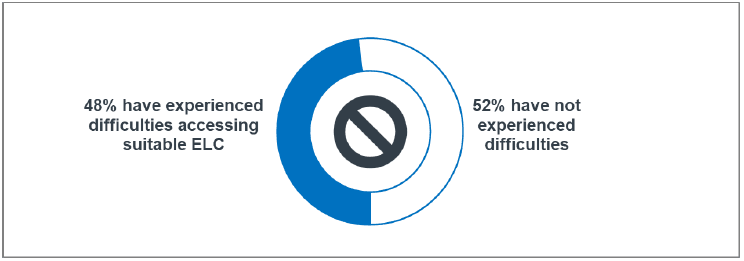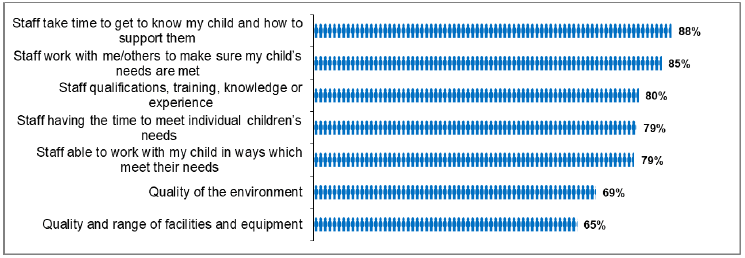Parents' views and use of early learning and childcare: report 2017
Information on parents’ and carers’ current use, future potential use, views and experiences of early learning and childcare.
This document is part of a collection
Accessibility of Early Learning and Childcare
In addition to ELC provision being flexible enough to meet parents' needs, accessibility of provision is also identified as one of the key principles for the planned expansion in entitlement. 'Accessibility' in this context has three specific aspects:
- Geographical accessibility, ensuring all parents across Scotland can reach suitable providers without long travel times or high travel costs.
- Awareness of the funded entitlement and understanding how to access this.
- Access to ELC provision that meets the needs of children with Additional Support Needs ( ASN).
This section considers parent's views and experiences in relation to each of these aspects of accessibility, and identifies other potential barriers.
Travel times and geographical accessibility
Survey results showed that 85% of parents of eligible children live within 15 minutes of their current main ELC provider. A third of all those with eligible children reported a journey of less than 5 minutes (33%). A travel time of 5-15 minutes was most common, reported by just over half of parents of eligible children (52%) and 13% travel for 15-30 minutes. Fewer than 1 in 20 (3%) travel for 30 minutes or more to get to their main provider. This profile of travel times was consistent across most parent groups.
Figure 13: Travel time to main ELC provider (with eligible children who use ELC)

The survey was not able to distinguish travel times by mode of transport, and so for example, the large group of parents who reported a journey time of less than 15 minutes is likely to include some travelling by car, and some with a 15-minute journey on foot. The latter group may see their provider as less accessible than those travelling by car.
However, qualitative feedback suggested that while convenience of location is a factor in parents' choice of provider, relatively few see travel time as a significant barrier to their being able to make use of funded entitlement. To some extent this appeared to reflect parents being able to consider locations within a reasonable travel time of their workplace(s), in addition to their home. Some also referred to having chosen a provider based on travel time for grandparents or others who may be providing informal "wraparound" provision.
Parent B relies on grandparents as emergency contacts for their child's ELC provider. The grandparents' limited mobility and lack of transport options was an important factor in Parent B setting a relatively small search area for ELC providers – "thankfully I found a nursery I'm really happy with within walking distance".
This feedback is also reflected in survey results, which found that travel time is rarely a contributing factor for those who are not using any of their funded entitlement (mentioned by only around 1 in 20 of these parents). In addition, around 1 in 6 of the small number of parents who do not use their entitlement indicated that there are no available providers near them; although this is equivalent to just 0.3% of all parents with eligible children.
Qualitative feedback did identify a number of parents without access to a car or regular public transport, who saw location as a significant constraint on the range of providers they were able to consider. While these parents had been able to secure suitable provision, some felt that this had been "just down to luck" where travel time had limited their choice of providers. This included examples of parents in more rural areas with limited access to transport, and who felt that their local authority nursery was the only provider available to them.
"We're in a village and there isn't really any choice for nurseries. Luckily [the local authority nursery] is great, he absolutely loves it. I spoke to people to see what they thought of it, we were getting good reviews…but if we found out it wasn't very nice it would have been a really difficult situation."
Awareness and other barriers to use of entitlement
As is discussed earlier in this report (see "Use of early learning and childcare"), a large majority of parents of eligible children were using at least part of their funded entitlement . For the small minority of parents not currently using any of their funded hours, around a fifth identified that this was down to a lack of awareness – although this is equivalent to just 0.4% of all parents with eligible children.
A proportion of parents not using their funded hours also indicated this was due to not being aware of how to apply or concern that applying is too difficult. This was mentioned by around 1 in 7 of those not using funded hours for 3 or 4-year olds, and around 1 in 10 for 2-year olds – although this equates to only around 0.2% of parents with eligible children.
In addition to the limited impact of travel and awareness on parents' access to ELC (as noted above), qualitative feedback also suggested that parents' use of funded hours can be constrained by a lack of information on available providers and in some areas a lack of available places.
Feedback indicated that a lack of access to information on available providers has been an issue for parents in securing a suitable package of ELC. This was highlighted as an issue by a diverse range of parents, including those across urban and rural location, different household types, and higher and lower income groups. A lack of access to information was mentioned by these parents as leading to specific difficulties such as finding local authority nurseries with available places, identifying partnership nurseries where funded hours can be used, and locating up-to-date information on active childminders.
When seeking ELC for their first child, Parent C approached the Council and others for information on available providers but was unable to find a single source of information on different types of provider.
Some parents suggested that advice from health visitors or support workers, and word of mouth from family and friends had been the most effective sources of information on available providers – but noted that not all parents will have access to this.
"I just had to keep phoning to find somewhere with places available – I have absolutely no idea of how the system works…but that's what my friends advised me to do."
Some parents also raised concerns around the availability of ELC places in their local area, and felt that supply of places is insufficient to meet demand. This appeared to be a particular issue in highly populated urban areas. These parents cited examples of being required to approach multiple providers (10 or more) to find an available place, and of parents being unable to use their funded entitlement due to a lack of available places. Again, these parents felt there is a need for better information on providers with available funded places, and on how parents can maximise their chances of accessing a place.
The majority of parents (74%) indicated that they were aware of the planned expansion in funded entitlement. However, only half were "definitely" aware of the planned changes (50%).
Figure 14: Awareness of planned expansion in entitlement

There remained around a quarter of survey respondents (26%) who were not aware of the planned expansion. This level of awareness was similar for parents with children who are eligible for the current entitlement and other parents, but awareness varied across a number of parent groups – further detail is provided later in this section. Regression analysis was undertaken to control for any inter-relatedness between parent groups, and showed that household income and age have the greatest impact on parents' awareness of the ELC expansion (lower income households and under 35s less likely to be aware).
Accessibility for children with Additional Support Needs
The third aspect of accessibility for the planned expansion in entitlement is ensuring access to suitable provision for children with Additional Support Needs. Around 1 in 20 of those taking part in the survey had one or more children aged under 6 with ASN (5%). [11] Language and/or cognitive needs were most common including reference to language, speech or communication issues, children on the autism spectrum, and social, emotional and/or behavioural difficulties. A fifth of parents of a child with ASN indicated that this related to a physical and/or mental health problem.
Most parents of children with ASN (57%) were satisfied with their access to ELC that suits their child's needs. However, there remained nearly a fifth of these parents (18%) who were dissatisfied with their access to suitable provision. This balance of views was broadly consistent across different types of ASN; for example, there was no significant difference in satisfaction levels between parents mentioning cognitive or physical needs.
Figure 15: Satisfaction with access to ELC to meet additional support needs

Although a relatively small minority are dissatisfied with their access to suitable ELC, nearly half (48%) of parents of children with ASN mentioned having experienced one or more difficulties accessing suitable provision. This was consistent across key parent groups and types of ASN.
Figure 16: Whether experienced difficulties accessing provision to meet ASN needs

Feedback from these parents indicated that difficulties are most commonly related to a lack of information on how providers support children with ASN, and concern that staff do not have the time required to meet their child's needs. Parents also mentioned concern that staff may lack the required qualifications, skills and experience to support their child's needs.
Figure 17: Type of difficulties encountered accessing provision to meet ASN needs

Note: Parents could select multiple options.
Qualitative feedback highlighted a similar range of concerns and difficulties in meeting the needs of children with ASN. For example, several parents had difficulty judging the ability of providers to meet their child's needs – including some who felt unable to judge the overall quality of providers. Some parents also felt that a lack of choice of provision negated their ability to compare the relative suitability of providers.
"I didn't have much information to go on [on how providers meet ASN], just word of mouth really."
Staff time and experience was also highlighted as a particular focus in parents' judging the suitability of providers. This included examples where children had benefitted from new staff with experience in meeting their specific needs. Some parents felt that visits to providers had been useful in assessing staff attitude and levels, but they felt less able to judge staff skills and experience. In addition, several parents had chosen local authority nurseries linked to a primary school as they felt staff were more likely to have relevant experience, or could draw on the wider experience of school staff.
Parent D has a pre-school age child with a diagnosis of autism who qualified for a funded place from 2 years old. Parent D felt they had no real choice of ELC providers able to meet their child's needs at that age, and that "it's just pot luck" that the only suitable provider was accessible in terms of location and cost.
Parents also highlighted the importance of stability in ELC provision for children with ASN. Difficulties were noted where parents are required to use multiple providers, and where handovers between multiple providers have a negative impact on their child's needs. Feedback also provided examples where use of the same childminder had provided valuable consistency through their child's movement between nurseries, and ultimately into primary school.
Parents of children with ASN were also asked about the key factors that they would consider when choosing a provider that meets their child's needs.
Parent E's child received an ASN diagnosis while attending a local authority nursery. Parent E was generally happy with the level of support provided, but saw a significant improvement in the quality of support when a staff change brought specific experience of their child's condition.
Staff were typically seen as the key factor in parents' choice of provider. This included staff having the time to tailor their approach to their child's needs (88% would take this into account), staff working with parents and others to meet the child's needs (85%), and staff qualifications, training, knowledge and experience (80%). Parents of a child with ASN were also more likely than others to mention staff skills and experience as a factor in their choice of current provider.
Figure 18: Factors influencing choice of provision to meet ASN needs

Note: Parents could select multiple options.
In terms of likely future uptake of the expanded entitlement, there was no significant variation between parents of children with ASN and others; 75% expect to take up all or almost all of the expanded hours for a 3/4-year-old (identical to other parents), and 57% for a 2-year-old (compared to 61% of others). We discuss this in more detail under "Likely future use of 1140 hours".
Views and experiences across parent groups
The research identified some significant variation across parent groups in views and preferences on geographical accessibility, awareness of the funded entitlement, and access to provision suitable for children with ASN.
This variation primarily related to income, deprivation and whether parents pay for ELC. For example, lower income households, single earners and those in the most deprived areas were less likely than others to be aware of the planned expansion in funded hours. In contrast, those who pay for ELC were more likely to be aware of the planned expansion.
Below we summarise the main variations across parent groups, highlighting where parents were significantly more or less likely than those in other parent groups to give a specific response.
| Low incomes/Most deprived areas |
Less likely to be aware of the planned expansion in funded hours. More satisfied with access to provision for children with ASN. |
|---|---|
| Rural areas |
More likely to travel for less than 5 minutes to their main ELC provider. |
| Single earner households |
Less likely to be aware of the planned expansion in funded hours. |
| Parents of children with ASN |
No significant variation. |
| Currently pay for ELC |
More likely to travel for 15 minutes or more to their main provider. More likely to be aware of the planned expansion in funded hours. Less satisfied with access to provision for children with ASN. |
| Do not currently use funded ELC |
No significant variation. |
| Other significant differences |
Parent age: Under 35s are more likely to travel for less than 5 minutes to their main ELC provider. Over 35s are more likely to be aware of the planned expansion in funded hours. Parent gender: Males are more likely to travel for less than 5 minutes to their main ELC provider. Females are more likely to be aware of the planned expansion in funded hours. Parents not currently using ELC and those not in employment are less likely to be aware of the planned expansion in funded hours. |
Contact
There is a problem
Thanks for your feedback